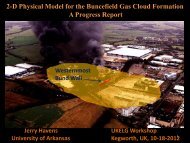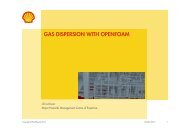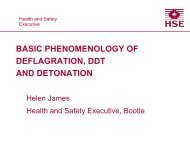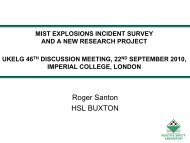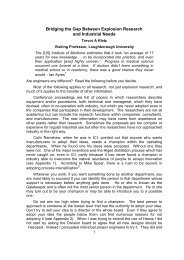Two-phase Modelling of Blast Mitigation Aaron Longbottom - ukelg
Two-phase Modelling of Blast Mitigation Aaron Longbottom - ukelg
Two-phase Modelling of Blast Mitigation Aaron Longbottom - ukelg
Create successful ePaper yourself
Turn your PDF publications into a flip-book with our unique Google optimized e-Paper software.
<strong>Two</strong>-Phase <strong>Modelling</strong> <strong>of</strong> <strong>Blast</strong> <strong>Mitigation</strong>Fluid Gravity<strong>Two</strong>-<strong>phase</strong> <strong>Modelling</strong> <strong>of</strong> <strong>Blast</strong><strong>Mitigation</strong><strong>Aaron</strong> <strong>Longbottom</strong>21 st September 2005 38 th UKELG Discussion MeetingVF009/05
<strong>Two</strong>-Phase <strong>Modelling</strong> <strong>of</strong> <strong>Blast</strong> <strong>Mitigation</strong>IntroductionFluid Gravity• MOD project on "<strong>Mitigation</strong> Techniques for Explosives"– blast and fragment mitigation– Mitigant in contact with, or in close proximity to, explosive device– 2002 to present• DSTL (Fort Halstead): experimental studies• FGE (St Andrews): theoretical modelling– Chris Mellor, Richard Brown, Scott Cargill, Andrew Milne, AlecMilne, <strong>Aaron</strong> <strong>Longbottom</strong>21 st September 2005 38 th UKELG Discussion MeetingVF009/05
<strong>Two</strong>-Phase <strong>Modelling</strong> <strong>of</strong> <strong>Blast</strong> <strong>Mitigation</strong>Aims <strong>of</strong> ProjectFluid Gravity• Understand both blast, fragment and combined blast/fragmentsystems• Wide range <strong>of</strong> devices (from kilograms to tonnes)• In terms <strong>of</strong> blast mitigation we are interested in:– Understanding basic physical processes involved– Reducing the blast effect– How blast process the mitigant– How this might affect fragment mitigation properties• Mitigant design21 st September 2005 38 th UKELG Discussion MeetingVF009/05
<strong>Two</strong>-Phase <strong>Modelling</strong> <strong>of</strong> <strong>Blast</strong> <strong>Mitigation</strong>DSTL ExperimentsFluid Gravity• Current charge sizes 10g to 10kg– Spheres above ground or hemispheres on ground• Granular or Liquid (droplet) mitigants– Generally a matrix <strong>of</strong> a component material in air– Continuum liquid → dispersed droplets• Key characteristics investigated:– Different component materials– Porosity– Density– Thickness– Stand<strong>of</strong>f– Charge size21 st September 2005 38 th UKELG Discussion MeetingVF009/05
<strong>Two</strong>-Phase <strong>Modelling</strong> <strong>of</strong> <strong>Blast</strong> <strong>Mitigation</strong>• 7.5kg PE4• ~16cm depth <strong>of</strong> water• Pressure gauges at 2m intervalsout to 14m• Gauges & movies can provide x-tplots for shock & particle cloudDSTL ExperimentsFluid Gravity21 st September 2005 38 th UKELG Discussion MeetingVF009/05
<strong>Two</strong>-Phase <strong>Modelling</strong> <strong>of</strong> <strong>Blast</strong> <strong>Mitigation</strong><strong>Two</strong>-<strong>phase</strong> TheoryFluid Gravity• <strong>Two</strong>-<strong>phase</strong>s:– Solid particle/liquid droplets– background material/gas• Set <strong>of</strong> continuum equations for each <strong>phase</strong>• Phases interact through– drag (scales as particle diameter)– nozzling– heat conduction (scales as square <strong>of</strong> particle diameter)– burning/evaporation• No longer hydrodynamic scaling (multiple length scales)21 st September 2005 38 th UKELG Discussion MeetingVF009/05
<strong>Two</strong>-Phase <strong>Modelling</strong> <strong>of</strong> <strong>Blast</strong> <strong>Mitigation</strong><strong>Two</strong>-<strong>phase</strong> Equations• Equation set based on work <strong>of</strong> Baer & Nunziato (1986)Fluid ConservationLawsMassMomentumEnergyStress DeviatorsVolume fractionClosureEquation <strong>of</strong> StateConstitutive ModelMass transferMomentum transfer(drag)Energy TransferParticle ConservationLawsMassMomentumEnergyVolume fractionClosureEquation <strong>of</strong> StateInter-particle StressMass transferMomentum transfer(drag)Energy TransferBurning Laws21 st September 2005 38 th UKELG Discussion MeetingFluid GravityVF009/05
<strong>Two</strong>-Phase <strong>Modelling</strong> <strong>of</strong> <strong>Blast</strong> <strong>Mitigation</strong>Why <strong>Two</strong>-<strong>phase</strong> Theory?Fluid Gravity• Each <strong>phase</strong> has its own velocity, temperature and pressure– Phases can flow though each other and coexist with different statevariables• We are interested in– Granular mitigants composed <strong>of</strong> particles– Liquid mitigants that break up into droplets• Particles/droplets accelerated/heated by explosive– Takes energy from system• Later slow and cool– Gives energy back to system21 st September 2005 38 th UKELG Discussion MeetingVF009/05
<strong>Two</strong>-Phase <strong>Modelling</strong> <strong>of</strong> <strong>Blast</strong> <strong>Mitigation</strong><strong>Two</strong>-<strong>phase</strong> vs. Continuum <strong>Modelling</strong>• Water layer in continuum (pure water) acts as piston– Can increase pressure over that <strong>of</strong> bare charge caseFluid Gravity• <strong>Two</strong>-<strong>phase</strong> (droplet) model allows flows through mitigant/air– Gives good agreement with experiment21 st September 2005 38 th UKELG Discussion MeetingVF009/05
<strong>Two</strong>-Phase <strong>Modelling</strong> <strong>of</strong> <strong>Blast</strong> <strong>Mitigation</strong>SummaryFluid Gravity• Investigating blast mitigation with mitigant in close proximity toexplosive• Extensive experimental program by DSTL studying keycharacteristics <strong>of</strong> mitigant systems• FGE has undertaken two-<strong>phase</strong> modelling <strong>of</strong> the mitigants• <strong>Two</strong>-<strong>phase</strong> theory gives good agreement for granular and liquid(droplet) based mitigants• Understanding underlying physical process' should enabledesign <strong>of</strong> new mitigant systems21 st September 2005 38 th UKELG Discussion MeetingVF009/05




